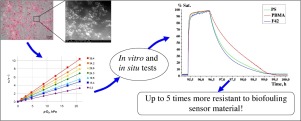Materials Today Communications ( IF 3.7 ) Pub Date : 2020-01-13 , DOI: 10.1016/j.mtcomm.2020.100916 A.Yu. Alexandrovskaya , P.V. Melnikov , A.V. Safonov , A.O. Naumova , N.K. Zaytsev

|
The control of the biotechnological reactors for the wastewater processing and for multiple biotechnological syntheses often requires the in situ monitoring of the current concentration of dissolved molecular oxygen (DO) within the reactor. The method of determining of DO based on the quenching of the indicator dye phosphorescence is becoming readily used due to be unaffected by sulfur-containing compounds and relatively insensitive to hydrodynamic conditions as compared with the traditional electrochemical sensors (the Clark electrodes).
Any types of sensors inserted into the biotechnological reactor however are objected to biofouling, that is the adsorption of the alive and dead cells of the microorganisms and also the formation of the attached polysaccharide matrix (the biofilm) on the surface of the sensor. Thus any DO sensor inserted into the bioreactor is subjected to two effects, that is 1) the actual change of the bulk DO concentration and 2) the deviation of the sensor readings due to the hindering of the oxygen diffusion to the indicator dye caused by the biofouling. In order to distinguish of these two phenomena we made two series of experiments in the present study. In the first series we subjected optical DO sensors with the sensitive layers manufactured of three different polymers that are polystyrene (PS), polybuthylmetacrylate (PBMA) and fluoroplast 42 (F42) to biofouling and tested the change of their response time in the pure model solutions with the known concentration of DO (in vitro experiments). In the second series we subjected optical DO sensors made of the same materials to the biofouling in the model biotechnological reactors and imitated the technological process of the aeration by purging for a while air throw the biological media (in situ experiments). The comparison of the sensors response in the first and in the second series can account for the contribution of the biofouling and the one of the bulk DO consumption processes.
In order to facilitate the dispersion of the indicator dye (Pt(II) 5,10,15,20-tetrakis(2,3,4,5,6-pentafluorophenyl)-porphyrin, PtTFPP) in the fluorinated matrix and to improve the quality of the sensor we applied an original core-dye-shell technology, where the indicator dye is first absorbed onto the surface of SiO2 particles and then covered by the shell made of the salt of two fluorinated surfactants, that is trimethyl-1-propanaminium iodide (FC-135) and tetraethylammonium perfluorooctanesulfonate (FT-248).
For the both in vitro and in situ experiments we used separately Saccharomyces cerevisiae yeast and Pseudomonas putida k12 bacteria.
All polymeric sensor films were observed to be vulnerable to the cell absorption and biofilm formation. The sensor with the membrane made of the F42 filled with core-dye-shell particles, was the only to provide the possibility to determine the actual concentration of DO after two weeks of the incubation in the bioreactor, the damage of the film due to biofouling being not critical.
中文翻译:

对光学氧气传感器的不同聚合物的抗生物结垢性的综合研究。基于核-染料-壳结构的新型氟化复合材料的优势
用于废水处理和多种生物技术合成的生物技术反应器的控制通常需要就地监测反应器中溶解的分子氧(DO)的当前浓度。与传统的电化学传感器(克拉克电极)相比,基于指示剂染料磷光猝灭的溶解氧测定方法由于不受含硫化合物的影响并且对流体动力学条件相对不敏感,因此变得易于使用。
然而,插入生物技术反应器中的任何类型的传感器都遭到生物污染,即吸附微生物的活细胞和死细胞,以及在传感器表面上形成附着的多糖基质(生物膜)。因此,任何插入到生物反应器中的溶解氧传感器都会受到两种影响,即1)溶解氧实际浓度的实际变化,以及2)由于氧气的扩散而阻碍了氧向指示剂染料扩散的传感器读数的偏差。生物污染。为了区分这两种现象,我们在本研究中进行了两个系列的实验。在第一个系列中,我们对光学DO传感器进行了处理,其敏感层由三种不同的聚合物制成,这些聚合物是聚苯乙烯(PS),体外实验)。在第二系列中,我们对由相同材料制成的光学DO传感器进行了模型生物技术反应器中的生物污染处理,并通过吹了一会儿空气以喷射生物介质来模拟曝气的工艺过程(原位实验)。在第一系列和第二系列中传感器响应的比较可以说明生物污染的贡献和大量DO消耗过程中的一个。
为了促进指示剂染料(Pt(II)5,10,15,20-四(2,3,4,5,6-五氟苯基)-卟啉PtTFPP)在氟化基质中的分散并改善传感器的质量我们采用了独创的核壳技术,其中指示剂染料首先被吸收到SiO 2颗粒的表面,然后被由两种氟化表面活性剂的盐制成的壳覆盖,即三甲基-1-碘化丙锭(FC-135)和全氟辛烷磺酸四乙铵(FT-248)。
对于体外和原位实验,我们分别使用了酿酒酵母酵母和恶臭假单胞菌k12细菌。
观察到所有聚合物传感器膜都容易受到细胞吸收和生物膜形成的影响。具有由F42制成的膜并填充有芯染料-壳颗粒的传感器,是唯一可以在生物反应器中孵育两周后确定DO的实际浓度的方法,该污染是由于生物污垢而造成的膜损坏不重要。











































 京公网安备 11010802027423号
京公网安备 11010802027423号